Solar Agent – Opportunity Available
Solar Agent
Join our team and be an agent of change, helping clients navigate their choices to determine whether and how to put grid-tied solar pv on their home.
You will have technical sales expertise, a driver’s license and clean driving record, and a desire to help our clients understand and make choices to harvest solar energy on their homes and businesses. You will be joining a small company and working alongside the owners. You will professionally represent us with integrity and excellent communications skills utilized for coordinating with the public, our clients, utilities and government regulators, and other departments within the company. You will be brutally honest, have excellent math and writing skills, be comfortable using a 32’ extension ladder to reach second story roofs. You will use company laptop, and vehicle. You will live in or around Port Townsend.
Specific tasks include:
- educating and qualifying customers over the phone and in person
- site analysis using ladder, hand tools, compass, camera, and cool high-tech shade analysis tools
- conceptual design and communication of financial cost, incentives, savings, and financing options during site visit
- detailed system design including performance estimates, requires good math skills including trigonometry and basic understanding of electricity and physics
- preparation of proposals, contracts using Word, Excel, SketchUp and solar design software
- answering questions in order to close the sales
- creating detailed project binders for the installation crew, including basic electrical calculations and one-line drawings
- creating basic permit applications using manufacturer’s engineered specs, shepherding applications through various jurisdictions
Additional marketing tasks may include graphic design of marketing materials, writing press releases, event coordination, and public speaking at indoor and outdoor events.
We provide a competitive compensation and benefits package including health insurance, paid sick and vacation time, paid and unpaid holidays throughout the year, quarterly bonuses based on profitability, 3% company IRA matching contribution, and continuing education funding.
Send resume and brief statement of your thoughts regarding renewable energy and grid-tied pv.
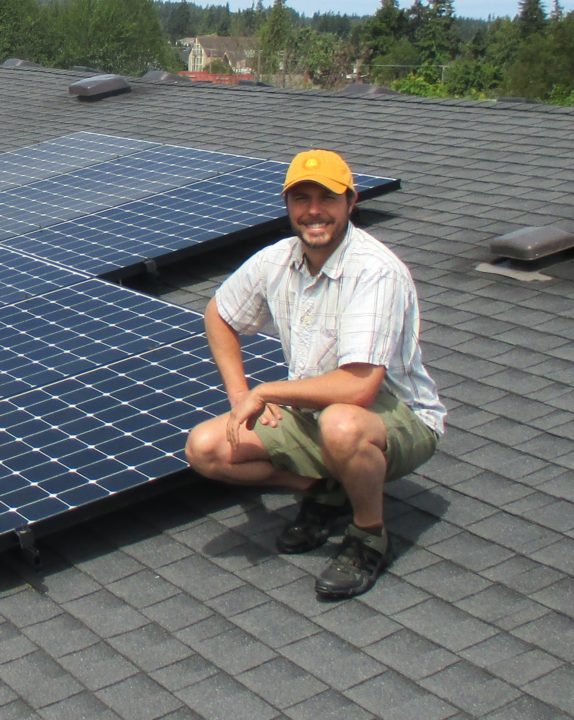
SunPower’s New Record Solar PV Module Efficiency – The Importance of Efficiency on Residential Rooftop Solar
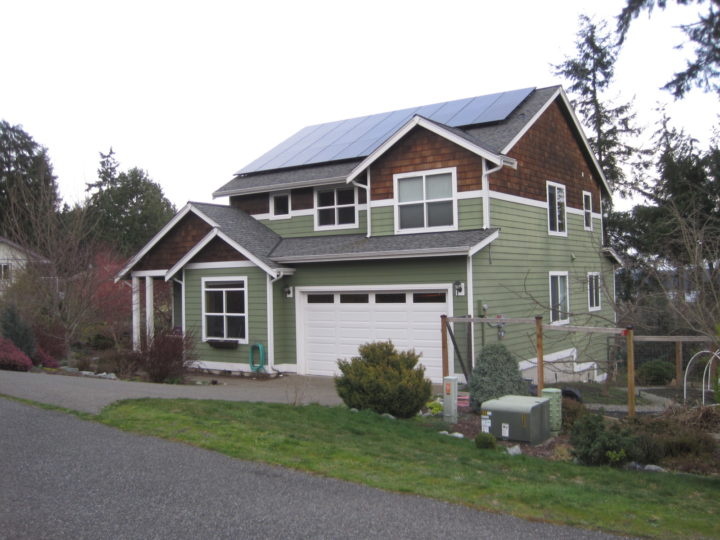
Mansfield Residence – 7.85 KW SunPower Array on Fronius 10 KW Inverter – Port Townsend – December 2015
SunPower last year verified 25.2% efficiency in a manufactured silicon-based PV cell. This year, they have integrated that cell into a manufactured PV module which attains 24.1% efficiency. When making efficiency comparisons, the cell-level efficiency is less relevant as in order for us to utilize that power, we need the cells built into a module, which will necessarily be slightly less efficient due to the space between cells, and the small area occupied by the frame.
When we are designing a system for a home’s roof, we usually need to make as much power as we can on the available roof space in order generate the largest percentage of the home’s annual energy. So using the most efficient modules available is important to us. While these SunPower modules are not the least expensive on the market, when we can put up an array with higher power rating in the same space as an average array, we can recognize relatively lower $/watt installation costs on all the other aspects of the system.
We are now commonly utilizing SunPower X-21 345 watt modules, which are 21.5% efficient at the module level. Their high efficiency, finish quality, and industry-leading warranty make SunPower an excellent choice for almost all of our clients. For example on the installation from last winter pictured above, we used the SunPower 327 watt modules to get 7.85 KW in the available un-shaded space. If we had used an average module, running ~290 watts in this size right now, that would be a 6.96 KW array in the same space, 12% less power installed for the same amount of work.
https://us.sunpower.com/blog/2016/06/26/sunpower-solar-module-verified-241-percent-efficient/
For all Solar Homeowners – Remember the June 30th Production Meter Reading Date
The annual Washington solar production incentive payments are based on the fiscal year from July 1 – June 30, so everybody with a grid-tied pv system is about to read their meters for the 2015/2016 year.
You will get a letter containing this form below. If you are a PSE customer, the form will be filled out for you. We are not certain what the Jefferson and Clallam PUD’s are planning this year. We have highlighted some of the important fields.
The main thing you want to bear in mind is to go read your production meter on June 30. Even if you are in PSE territory and they are going to read your meter and provide the information for you, we recommend reading your meter yourself at least annually. Then you will want to compare that figure with last year’s June 30 reading in order to get your annual production figure for this year. You will also be able to copy your DOR Tax Reporting Number from the top of last year’s form.
Unless you are among the minority of our clients who have the Made in Washington PV modules from Silicon Energy or Itek, you will use the field highlighted to report your total kilowatt-hours for the year. Although the base rate is stated as $0.15, all utilities in which we operate are or will be pro-rating this base rate due to the fact that the applications are now exceeding the available incentive pool, of 0.5% of taxable utility revenues.
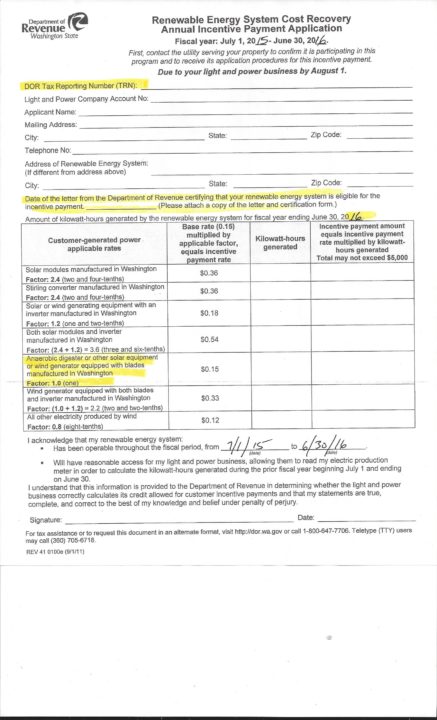
Jefferson Solar Tour and EV Round-Up – Saturday, July 9, 10 AM – 3 PM
In the midst of our series of 2016 Solar Tours, we bring the Jefferson Solar Tour and EV Round-Up. This will be our second year of making this Solar Tour petroleum-free. Last year, we had 6 different electric vehicles (Nissan Leafs, Toyota RAV4 EV, BMW i3, Smart EV, and Tesla) carrying tour-goers to the local solar homes.
The Jefferson Solar Tour is on Saturday July 9th, and will commence at 10 AM with tour orientation and Solar 101. The local solar homes will be open from 11 AM – 3 PM, and while this is a self-guided tour, we hope everyone can drive or be passenger in an electric vehicle. With our 10 KW PV system and Level II EV charging equipment here, we try to run these tours on 100% solar power.
Kick-off Location: Power Trip Energy, 83 Denny Avenue, Port Townsend, where you will be able to pick up maps and information, as well as ask questions of the Power Trip Energy staff.
10 AM – 11 AM “Spin Your Meter Backwards” Solar 101 workshop
10 AM – 3 PM: Tour info, Maps, & Staff available for questions
11 AM – 3 PM: Solar Homes Open for Touring

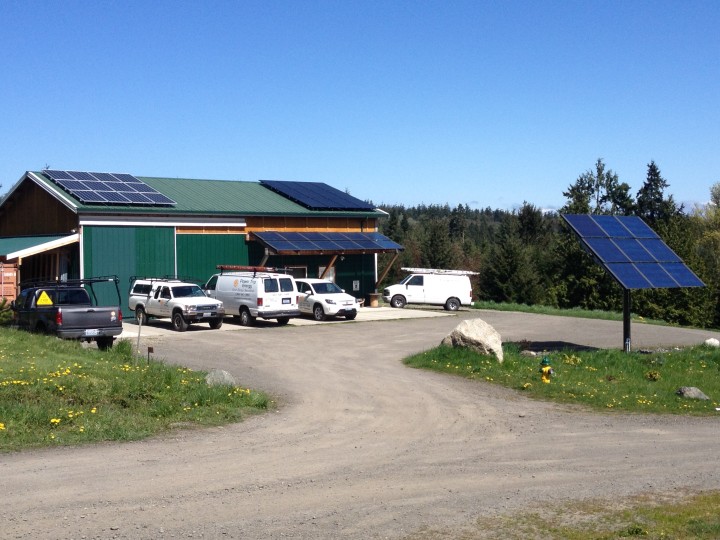
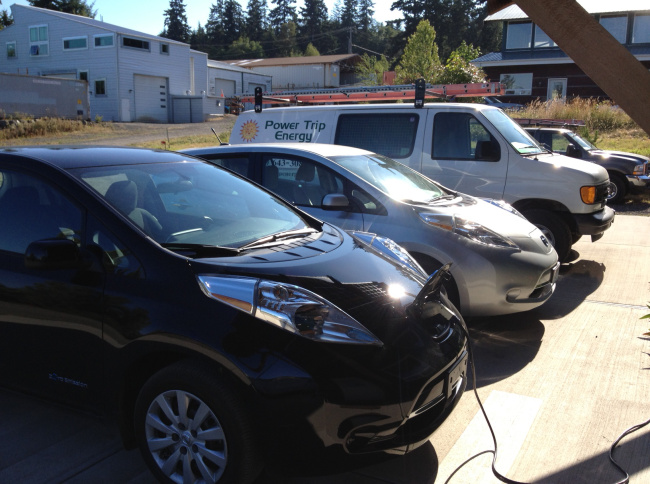
North Kitsap Solar Tour – First Solar Tour of the Season – Saturday May 14th
People tell us that the solar tours are the most valuable educational events we conduct. Over the years, we have created a curriculum and determined how to make a focused informational solar tour that works well for attendees and hosts alike.
For more details on the entire summer tour schedule, see https://powertripenergy.com/upcoming-events/solar-home-tours/
The first tour will involve three homes in North Kitsap (Kingston, Poulsbo, & Indianola) that are different examples of state-of-the-technology grid-tied solar PV systems.
The kick-off location for the North Kitsap Solar Tour will be the Kingston Community Center at 26159 Dulay Rd NE, Kingston, on Saturday May 14th. From 10 AM – 11 AM, there will be a brief presentation letting you know what you will see, and providing context for your site visits, maps will be available, and solar experts on hand to answer any questions. The sites themselves will be open for touring from 11 AM – 3 PM.
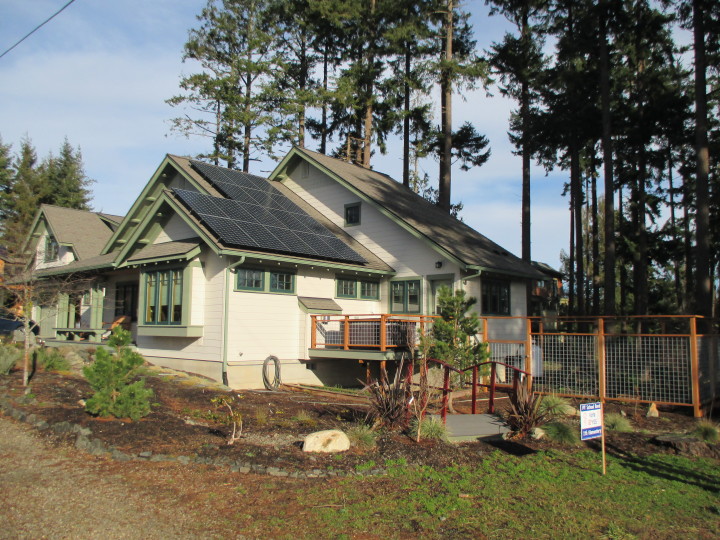
High solar demand, lower equipment prices, higher wattages, bring continued solar installation growth on Olympic Peninsula
There are several trends in the solar industry that are benefitting us locally, and driving our growth. We are currently installing over 60 KW per month, having installed 180 KW in Q4 of last year, and Q1 of 2016. That means in each quarter, we are installing as much solar as we did the first five years of business from 2003 through 2007.
We continue to see prices on pv modules slowly decrease, mostly as a result of global manufacturing capacity increases and efficiency gains. SunPower specifically has seen recent gains at its fourth “Fab” and is now approaching producing 1500 MW of pv per year.
So as a result of this increased manufacturing capacity, SunPower has been able to give us a fairly significant price cut recently, in addition to adding a 360 watt version of their standard residential pv module. We have been installing mostly 327’s for the last year, though now the 345’s are very close in price per watt and will make up the bulk of our designs for the remainder of the year. In cases where we want to make the most power possible, we will give our clients the option of the 360 watt product.
The increased installation rate here at Power Trip Energy also creates an interesting dynamic in terms of our pricing. With more and larger projects being installed each month, without our overhead significantly increasing, we can lower our installation charges on each job. So the lower equipment costs are actually resulting in lower labor charges as well.
The extension of the federal tax credit has removed a major deadline we were facing at the end of 2016 so we can intelligently plan for manageable growth this year. The waning state incentives should be considered, since we have about four more good summers to capitalize on those annual production payments from the state.
We don’t know how long these market conditions will persist, but we do know there has never been a better time to install a grid-tied pv system in Washington.
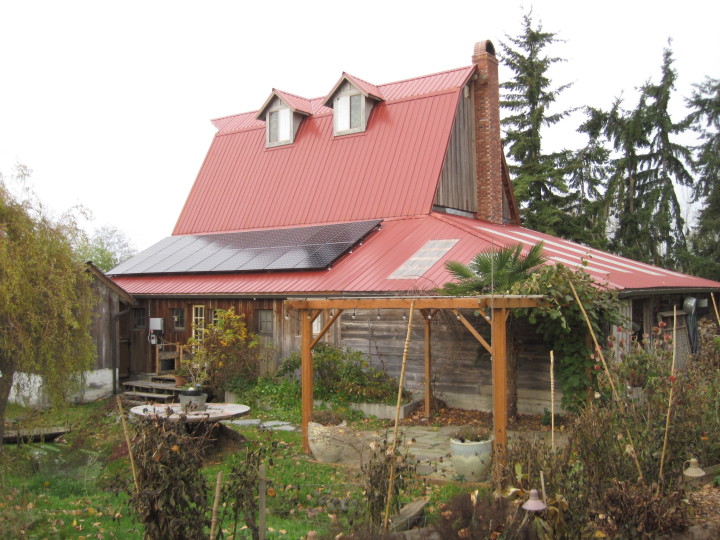
6.21kw SunPower, Sequim 2015
Are 10 Year old Solar PV Modules Obsolete?
Are 10 Year old Solar PV Modules Obsolete?
Nope.
This 10 year old array continues to produce returns with no additional investment on our part. Thanks to the Energy Edition of Industry Focus for bringing up this topic – http://www.fool.com/podcasts/industry-focus. Sean, Tyler and Taylor – I hope you appreciate my Foolish perspective.
SunPower Dealer Conference Report – Feb 2016
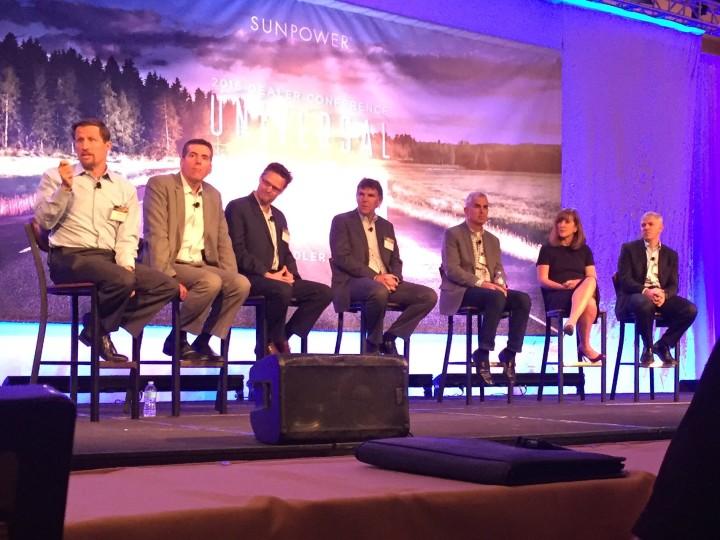
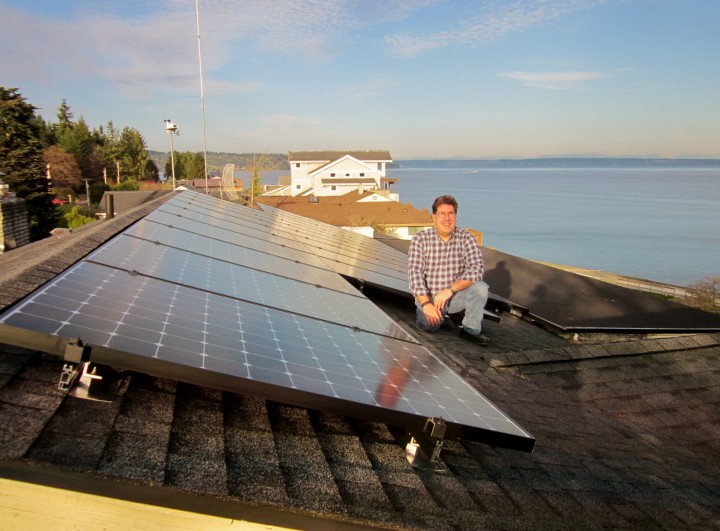
USDA REAP Grant Seminar – Wed, Feb 17 – 9 AM – 12 Noon – Chimacum Grange

Dungeness Valley Creamery dairy barn
In 2015, Power Trip Energy assisted three local businesses receive USDA REAP grants that provided 25% of the funds for solar PV and other energy efficiency projects. We have installed solar PV at two of these businesses and expect to install at the third once the development of their new location is complete.
- Ryan McCarthey of Dungeness Valley Creamery noted “The solar PV system purchased with the assistance of the REAP program helped us decrease our energy costs and become more energy-independent.” He also stated: “Producing our own clean renewable energy not only reduces operating expenses, but it helps us communicate to our customers our passion and goals as a business. Being environmentally conscious and big picture thinking is integral to our long term sustainability.”
- Eric Jorgensen of Finnriver Cidery commented: “Finnriver is extremely excited to be partnering with the USDA REAP program and a local solar installer to work on a major solar installation at our new facility. The advice and assistance we received from USDA program staff were very helpful in helping us submit our successful application. If you are considering any alternative energy improvements we highly recommend finding out if you might be eligible for this great program!” And Crystie Kisler of Finnriver added “It’s important for our community to explore alternative energy solutions and this grant offers us a way to bring more innovative projects into our area.”

Washington State Solar Incentives – Cost Recovery Program (Existing and Ending) and HB 2346 (Proposed Legislation Being Considered in Olympia Now)
As many of you know, the declining state solar incentives here in Washington State are scheduled to completely sunset June 30, 2020. The cost recovery program has been one block in the foundation of solar economics here in Washington State since 2007. In that time, we have seen continued geometric growth, increasing the installed KW by ~ 40% per year. However its success is the cause of distress in many areas. Because the cap on the incentive was fairly low, that cap has now been breached in many utility areas, including Jefferson PUD. In Jefferson PUD for the program year July 1, 2014 – June 30, 2015, incentive applications were approximately $225,000 and the overall incentive pool was only about $155,000, resulting in prorated payments down to 70% of the regular base rate. At the inception of this program, there was virtually no solar PV market in the state, and nobody expected to exceed these caps by this time. This is an unfortunate and unexpected loss for the early adopters now that solar has gone mainstream.
Without a remedy to the loss of state incentives, we may well see a leveling-off of the solar growth. This might well result in layoffs at our company and others across the state. In Washington State right now, there are 128 companies that self-identify as solar companies, employing about 2400 people, nearly all installers. At Power Trip Energy Corp, we currently employ 10 people, and have installed about 3 MW since 2003.
State-wide solar capacity is now 60 MW installed, up from 11 MW in 2014, and 6 MW in 2012. Almost all of this installed PV is customer-owned, distributed generation making power at the point of use, and paid for by the property-owners. The state offers no up-front rebates, however there is a sales tax exemption, and also the 30% federal tax credit, which has helped people decide to invest their own money in solar PV on their homes and businesses. The main support the state offers for the installation of PV is the production incentive which pays for all PV produced, creating an economic mechanism for the additional value we see in solar above and beyond electricity generated by coal, nuclear, and the federal hydro-system on the Columbia and Snake Rivers. As mentioned above, the state solar production incentive is nearing the end of its useful life.
Despite the current solar capacity of 60 MW seeming large to some of us, it is important to remember that this is still responsible for much less than 0.5% of our overall electricity portfolio.
There is currently proposed legislation that will create a second phase of state incentives, which will close the existing program and accept new enrollments through 2020 and would provide 10 years of incentive stability for new enrollees in which to make fair financial returns, while decreasing the incentive rate structure every year between 2017 and 2020. This is called HB 2346 – Promoting a Sustainable Renewable Energy Industry – and you can view the full details here: http://app.leg.wa.gov/
This bill is the result of a two year process bringing together multiple stakeholders including the nascent solar industry, utilities, environmental groups, and consumer advocates. We are strong supporters of this bill for many reasons.
Since 2002, we have placed our own self-interests inline with the belief that our community and our state would be well-served by developing a robust renewable energy infrastructure. We have made the case that individuals should invest in renewable energy on their own homes as a way to generate some of their own capital, decrease their dependence and expenditures upon utilities. This serves the individuals by increasing the value of their home, and decreasing their energy bills in the long run. It serves the community by keeping more money local, and making the overall community more resilient. It also contributes to the overall global benefit of producing energy without contributing the the carbon emissions of coal, the radioactive waste of nuclear plants, or the environmental degradation of the mammoth federal hydro system.
This bill supports those goals by allowing individuals to continue to benefit from investments they make in their own home through the diversion of a portion of the state’s utility tax. Due to the relative low caps per project on this incentive, it is only incentivising small (generally under 20 KW) solar pv arrays, which will nearly all be installed on residential and small business rooftops. Since these arrays are installed at the point of use, there are no inefficiencies from transmission losses.
In this way and others, the promotion of distributed solar energy benefits all ratepayers. Northwesterners do benefit from the cheap electricity produced from investments made in this federal system decades ago (despite its decimation of salmon and other problems). Likewise will future generations benefit from our efforts today, as we diversify our energy infrastructure with more solar producing clean renewable distributed energy.
For these reasons and more, we support HB 2346, and urge you to do the same.
